Training your quads is a key part of growing and defining your legs. Whether you are a workout enthusiast or designing your first training plan, the exercises below will help you meet your fitness goals.
suspended split squat
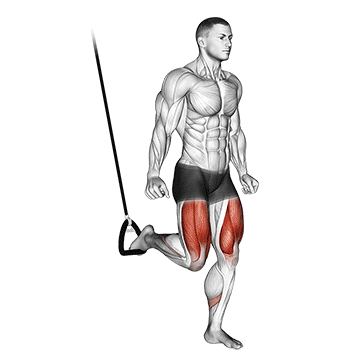
To perform the suspended split squat, you'll need a suspension trainer.
1. Start by adjusting the suspension trainer so that the handles are at about waist height.
2. Stand facing the anchor point and grab the handles with your palms facing each other.
3. Step back with your right foot and place it in one of the foot cradles. Your left foot should remain on the ground.
4. Lower your body into a split squat by bending your left knee and hip as if you were trying to kneel. Your right leg should remain straight and suspended behind you.
5. Push through your left heel to raise your body back up to the starting position.
6. Repeat this movement for your desired number of repetitions, then switch legs and repeat the exercise with your right foot on the ground and your left foot in the foot cradle.
Remember to keep your core engaged and your back straight throughout the exercise. This exercise primarily targets your quads, but it also works your glutes and hamstrings.
squat to overhead reach with twist
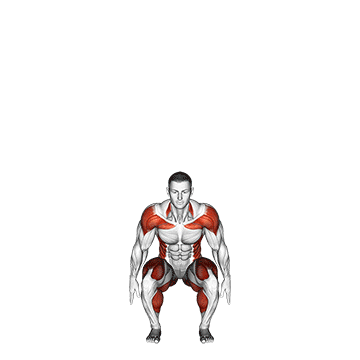
1. Stand tall with your feet hip-width apart. This is your starting position.
2. Begin by performing a regular squat. Bend your knees and push your hips back as if you're sitting in a chair. Keep your chest up and your weight in your heels.
3. As you lower into the squat, extend your arms straight out in front of you at shoulder height.
4. Push through your heels to stand back up to the starting position. As you rise, simultaneously lift your arms overhead.
5. Once you're standing tall with your arms extended above your head, twist your torso to the right, keeping your hips facing forward.
6. Return to the center and lower back into the squat position, extending your arms straight out in front of you again.
7. Repeat the movement, but this time twist your torso to the left as you stand and reach overhead.
8. Continue alternating sides with each rep.
Remember to keep your core engaged throughout the exercise and move in a controlled manner. This exercise not only targets your quads but also works your glutes, hamstrings, core, and shoulders.
squat to overhead reach
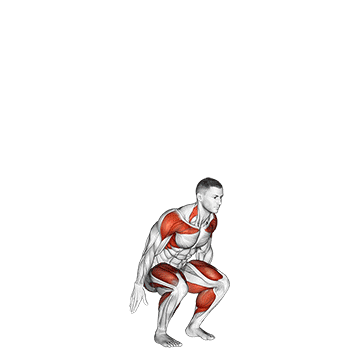
1. Stand tall with your feet hip-width apart. Your toes should be pointing forward or slightly outward. This will be your starting position.
2. Lower your body into a squat by bending your knees and pushing your hips back as if you're about to sit on a chair. Keep your chest up and your back straight. Your thighs should be parallel to the floor.
3. As you lower into the squat, extend your arms straight out in front of you at shoulder height. This will help you maintain balance.
4. Push through your heels to stand back up, straightening your legs and squeezing your glutes at the top.
5. As you stand, simultaneously reach your arms overhead, extending your body as tall as possible.
6. Lower your arms back to shoulder height as you return to the starting position.
7. Repeat this movement for your desired number of repetitions.
Remember to keep your core engaged throughout the exercise and don't let your knees cave in as you squat. This exercise can be performed in sets of 10-15 repetitions, depending on your fitness level.
split squats
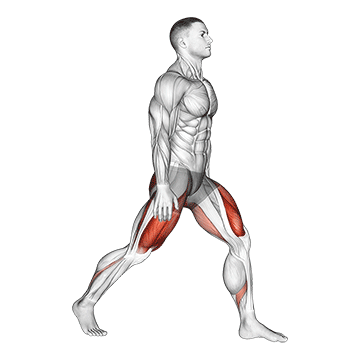
To perform split squats, start by standing upright with your feet hip-width apart. Take a step forward with your right foot, about two feet. This is your starting position.
Ensure your right foot is flat on the ground and your left foot is up on its toes. Keep your hands on your hips or extend them out in front of you for balance. Maintain a straight back and engage your core.
Slowly lower your body by bending your right knee until it forms a 90-degree angle. Your left knee should also bend and come close to touching the ground. Make sure your right knee is directly above your right ankle and does not extend past your toes.
Pause for a moment at the bottom of the movement, then push through your right heel to return to the starting position. This completes one rep.
Repeat this movement for your desired number of repetitions. Then switch legs and perform the same number of repetitions with your left foot forward.
Remember to keep your torso upright and your hips square throughout the exercise. This will help to engage your quads and ensure you're performing the exercise correctly.
No equipment is needed for this exercise as you're using your own body weight for resistance. However, as you get stronger, you can hold dumbbells in your hands to increase the difficulty.
sissy squat
To perform a sissy squat, start by standing upright with your feet shoulder-width apart. Keep your back straight and your hands either out in front of you for balance or on your hips.
Next, slowly lift your heels off the ground and lean your torso backward slightly. This is your starting position.
Begin the exercise by bending your knees and lowering your body towards the ground. Keep your back straight and your heels lifted throughout the movement. Lower yourself as far as you can while maintaining control and balance.
Pause for a moment at the bottom of the movement, then push through your toes to raise your body back to the starting position.
Remember to keep your core engaged and your movements controlled throughout the exercise.
Repeat this movement for your desired number of repetitions.
This exercise primarily targets your quadriceps, but also works your glutes and core. It can be performed without any equipment, using just your body weight for resistance.
Remember to warm up before starting the exercise and cool down afterwards. If you're new to sissy squats, you may want to start with a lower number of repetitions and gradually increase as your strength and balance improve.
quick feet v. 2
To perform the Quick Feet V. 2 exercise, start by standing straight with your feet hip-width apart. This exercise doesn't require any equipment, just your body weight.
1. Begin by bending your knees slightly and lowering your body into a half-squat position. This is your starting position.
2. Now, start moving your feet as fast as you can. The movement should be similar to running in place, but your feet should only be lifting a few inches off the ground.
3. Make sure to stay on the balls of your feet and keep your arms bent at your sides, moving them back and forth in rhythm with your feet.
4. Keep your core engaged and your back straight throughout the exercise.
5. Continue this quick foot movement for about 30 seconds to a minute, depending on your fitness level.
6. Rest for 30 seconds and repeat the exercise for 3-5 sets.
Remember, the goal of this exercise is speed, so try to move your feet as fast as possible. This will not only work your quads but also get your heart rate up for a great cardio workout.
quads
Begin by standing upright with your feet hip-width apart. This will be your starting position.
Next, lower your body by bending at the knees as if you were going to sit back into a chair, keeping your back straight and your chest up. Make sure your knees are directly above your ankles, not pushed out too far forward.
Lower yourself until your thighs are as parallel to the floor as possible, with your knees over your ankles. Press your weight back into your heels.
Hold this position for a moment and then push through your heels to bring yourself back to the starting position.
This is one repetition. Aim to complete 3 sets of 10-15 repetitions, or as many as you can manage with good form.
Remember to keep your core engaged throughout the exercise and to breathe €“ inhale as you lower yourself down, and exhale as you push yourself back up.
This exercise, known as a bodyweight squat, is a great way to target your quadriceps using just your body weight.
lying (side) quads stretch
1. Start by lying down on your right side on a comfortable, flat surface. Your legs should be extended straight out and your body should be in a straight line.
2. Rest your head on your right arm or hand for support.
3. Bend your left knee and reach back with your left hand to grab your left foot or ankle. If you can't reach your foot, you can use a towel or strap around your foot to help.
4. Gently pull your left foot towards your buttocks until you feel a stretch in the front of your thigh. Make sure to keep your hips stacked and don't let your left knee drift forward.
5. Hold the stretch for about 30 seconds, breathing deeply and relaxing into the stretch.
6. Slowly release your foot and straighten your leg back out.
7. Roll over onto your left side and repeat the stretch with your right leg.
8. Aim to do this stretch 2-3 times on each side.
Remember to keep the stretch gentle and never force your foot further than is comfortable. The goal is to feel a gentle stretch, not pain.
forward jump
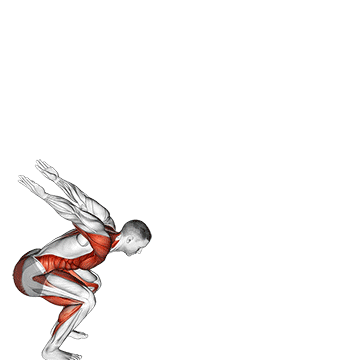
To perform the forward jump exercise, start by standing tall with your feet hip-width apart. Your arms should be by your sides, and your body weight should be evenly distributed between both feet.
Engage your core and lower your body into a squat position by bending your knees and pushing your hips back. Your thighs should be as parallel to the floor as possible, and your knees should be aligned with your toes. Swing your arms back for momentum.
Next, explosively push off the ground, jumping forward as far as you can. Extend your legs and swing your arms forward to help propel your body. Aim to land softly on the balls of your feet, then immediately lower back into the squat position.
This is one repetition. Aim to complete a set of 10-15 jumps, or as many as you can manage with good form. This exercise primarily targets your quads, but also works your glutes, hamstrings, and calves. Remember to keep your core engaged throughout the exercise to maintain balance and stability.
As with any exercise, start with a lower intensity and gradually increase as your strength and endurance improve. Always warm up before starting the exercise and cool down afterwards to prevent injury.
chair leg extended stretch
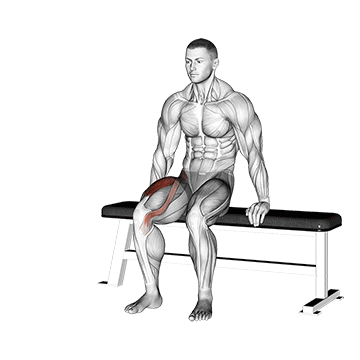
Begin by standing upright behind a chair, using the back of the chair for support. Make sure your feet are hip-width apart.
Slowly lift your right foot off the ground, bending your knee and bringing your heel towards your buttocks. Hold onto the back of the chair with your right hand for balance.
Extend your left arm out in front of you for additional balance if needed. Keep your chest lifted and your spine straight.
Hold this position for 20-30 seconds, feeling a stretch in your right quadriceps.
Slowly lower your right foot back to the ground.
Repeat this stretch with your left leg, lifting your left foot off the ground and bringing your heel towards your buttocks. Hold onto the back of the chair with your left hand for balance.
Again, hold this position for 20-30 seconds, feeling a stretch in your left quadriceps.
Repeat this exercise for 3-5 rounds on each leg. Remember to breathe deeply and maintain good posture throughout the exercise.
balance board
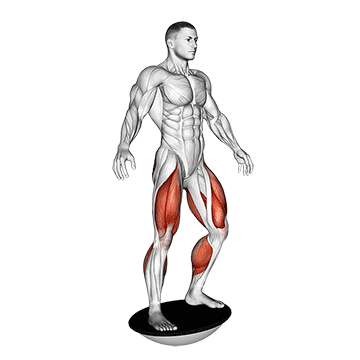
To perform the balance board exercise, start by placing the balance board on a flat, stable surface. Stand up straight and step onto the board, placing your feet hip-width apart. Make sure your toes are pointing forward and your weight is evenly distributed between both feet.
Engage your core and keep your back straight as you start to shift your weight from side to side. This will cause the board to tilt. The goal is to maintain your balance and keep the board from touching the ground.
To target your quads, bend your knees slightly as if you're about to sit in a chair. This will engage your quads and increase the difficulty of the exercise.
Try to maintain this position for as long as possible, aiming for at least 30 seconds to start. As your balance and strength improve, you can increase the duration.
Remember to breathe evenly throughout the exercise and keep your movements slow and controlled. If you lose your balance, step off the board and reset before starting again.
This exercise can be repeated several times, with a short rest in between each set. It's a great way to improve your balance and strengthen your quads using just your body weight.
backward jump
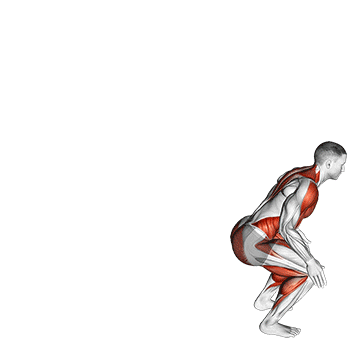
To perform the backward jump exercise, start by standing straight with your feet hip-width apart. Your arms should be relaxed by your sides. This is your starting position.
Next, bend your knees slightly and push your hips back while swinging your arms behind you. This is the loading phase of the jump. Make sure to keep your back straight and your chest up during this phase.
Then, in a swift and explosive movement, push off the ground with both feet and jump backward. Swing your arms forward as you jump to help propel your body backward. Aim to jump as far as you can, but make sure you maintain control of your body.
Land softly on your feet, absorbing the impact by bending your knees and pushing your hips back. Your arms should swing back behind you as you land. This is one repetition.
Repeat the exercise for the desired number of repetitions. Make sure to maintain proper form throughout the exercise to target your quads effectively and prevent injury.
Remember, this exercise requires a certain level of coordination and balance. If you're new to this exercise, start with small jumps and gradually increase the distance as you get more comfortable.
all fours squad stretch
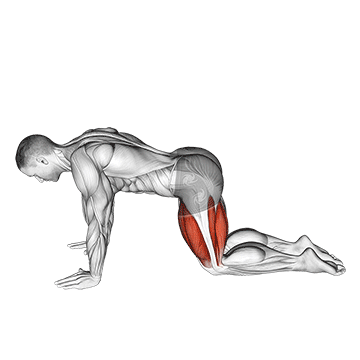
Begin by getting down on all fours on a comfortable surface, such as a yoga mat. Your hands should be directly under your shoulders and your knees directly under your hips.
Next, extend your right leg straight out behind you, keeping your toes pointed and your foot flexed. This is your starting position.
Now, bend your right knee and try to bring your heel as close to your buttock as possible. You should feel a stretch in your right quad. Hold this position for a few seconds.
Then, slowly extend your right leg back out to the starting position.
Repeat this movement for your desired number of repetitions, then switch to your left leg.
Remember to keep your back straight and your core engaged throughout the exercise. Breathe deeply and evenly, exhaling as you bring your heel to your buttock and inhaling as you extend your leg.
This exercise can be done as part of a warm-up or cool-down routine, or as part of a lower body strength training session.
No tags for this post.
